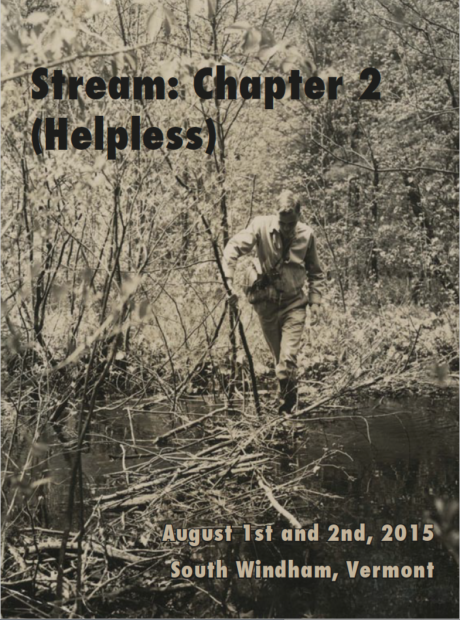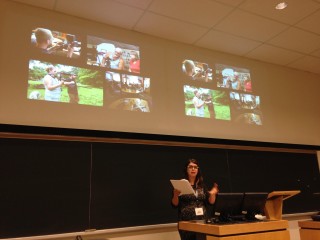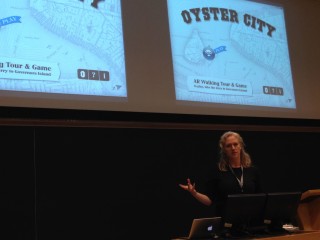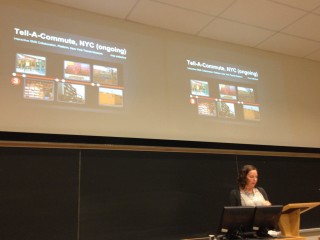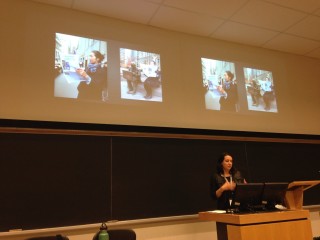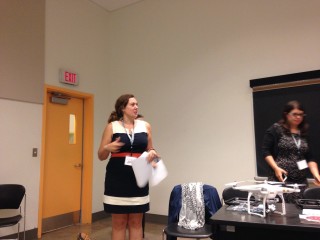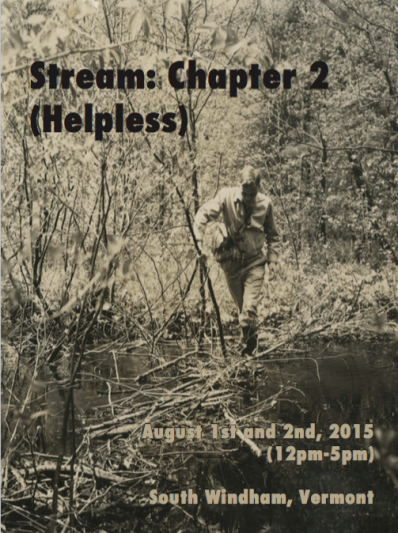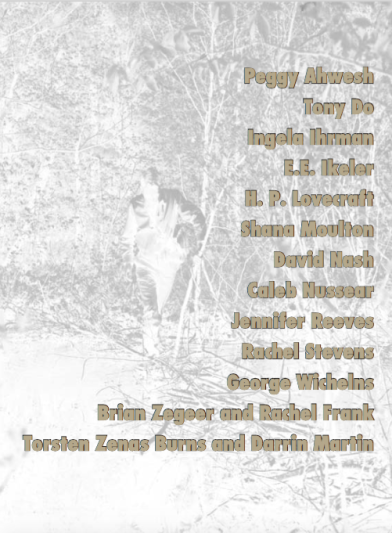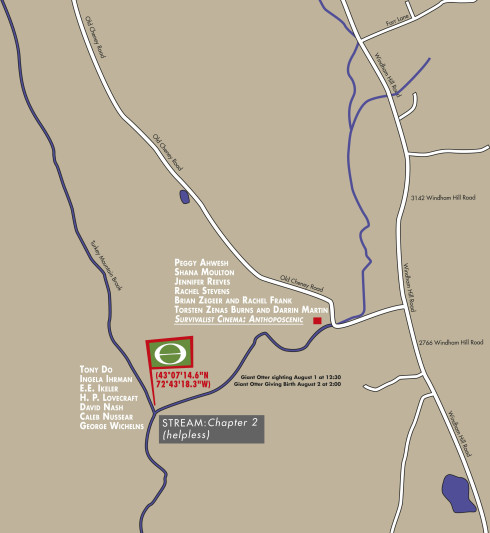Stream 2 Catalog
The Stream: Chapter 2 (helpless) catalog is finished and available for download.
Includes work by:
Peggy Ahwesh
Torsten Zenas Burns and Darrin Martin
Tony Do
Ingela Ihrman
E.E. Ikeler
H. P. Lovecraft
Shana Moulton
David Nash
Caleb Nussear
Jennifer Reeves
Rachel Stevens
George Wichelns
Brian Zegeer and Rachel Frank
Signal Fire residency: Unwalking the West
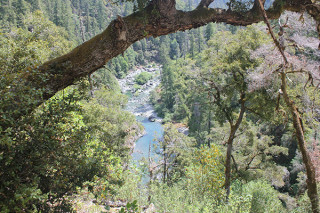 I am truly excited to participate in a residency this June with Signal Fire (not to be confused with the “media project of the Maoist Communist Group” nor the reimagined venture capital firm, two entities with the same name) called Unwalking John C. Frémont. It is part of their Unwalking the West theme this year. We (ten artists and two artist-guides) will be hiking, camping and backpacking in the Upper Klamath Basin region of southern Oregon while taking a deep dive into environmental, social and political issues that affect the area. Such a terrific opportunity to research and connect with a landscape in the far west for this native of Northern California who has been living the NYC life for maybe too long.
I am truly excited to participate in a residency this June with Signal Fire (not to be confused with the “media project of the Maoist Communist Group” nor the reimagined venture capital firm, two entities with the same name) called Unwalking John C. Frémont. It is part of their Unwalking the West theme this year. We (ten artists and two artist-guides) will be hiking, camping and backpacking in the Upper Klamath Basin region of southern Oregon while taking a deep dive into environmental, social and political issues that affect the area. Such a terrific opportunity to research and connect with a landscape in the far west for this native of Northern California who has been living the NYC life for maybe too long.
Description from their site:
What Western U.S. city doesn’t have a street named after “The Pathfinder,” John C. Frémont? This trip revisits portions of the route of Frémont’s calamitous Second Expedition (1843-4), a foray into empire-building conducted under the guise of exploration. Frémont’s journey provides an entry point to learning about an exceptional and very contested place: the Upper Klamath Basin.
We will begin our trip in the ancestral land of the Modocini, Mak’Lak and Yahooskin tribes (comprising The Klamath Tribes). Our contextual materials will include an introduction to Klamath’s ecological “knot” as well as focus on Indigenous Survivance and sovereignty, from the Modoc War to the contemporary fight for Indigenous water and fishing rights. We will introduce content about the current political landscape of a place that sees very different communities working together to solve conflicts over vital natural resources.
Both local and visitors’ voices will contribute to our understanding of the forces that have shaped the Basin: dams, grazing, and land theft, as well as problem solving through patient and resourceful strategies. We’ll spend the first half of the trip in the former Klamath reservation at Chiloquin, Modoc Point and traveling along the Sprague River, visiting important cultural sites and meeting with visiting presenters. Then we’ll head into the Lava Beds National Monument to visit the strongholds of the Modicini where Kintpuash (Captain Jack) and a band of Modocs successfully fought off the U.S. Government troops for 5 months in the late 1800’s. The second half of our trip will include a short backpacking adventure in the mountains surrounding the Klamath Basin—wildlands whose waters feed this oasis.
Site-Specific Doc at Visible Evidence 22
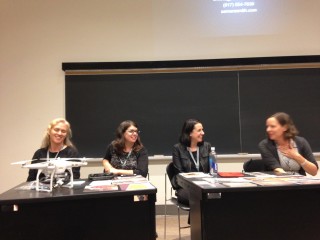 Last weekend we had a great panel/workshop at the Visible Evidence 22 conference in Toronto: Site on Screen: Emerging Technology and Site-Specific Documentary Practice
Last weekend we had a great panel/workshop at the Visible Evidence 22 conference in Toronto: Site on Screen: Emerging Technology and Site-Specific Documentary Practice
Track: Expanded Documentary and Immersive Technologies.Type: Workshop Keywords: Mobile media, Locative media, Site-specific, Participatory, Collaborative, Psychogeography, Documentary, Experimental, Socially engaged, Interactive
In this workshop, documentary media artists Laura Chipley, Sarah Nelson Wright, Samara Smith, A.E. Souzis and Rachel Stevens will discuss site-specific documentary practice, highlighting their individual and collaborative location-based documentary projects and exploring how site-specific documentary practices have evolved with changing mobile and locative technology. All of the documentary projects to be discussed are site-specific explorations of physical spaces that augment or invite public participation in chronicling the physical world with mobile media. Technologies explored will include: audio, SMS messaging, augmented reality, sensors, go-pros, underwater cameras and aerial photography. Each presenter will open with a short overview of her body of site-specific documentary work focused on the central questions of the panel: How has your site-specific documentary practice evolved with new mobile technologies? How have new technologies influenced concept, form, collaboration, participation, interaction and audience experience? How do new technologies expand documentary audiences? Each artist will reflect on a body of experimental documentary work that demonstrates an evolution in engagement strategies blurring the lines between subject/audience and location/screen to expand the traditional documentary form and experience. After brief introductory presentations, the panel will engage in a discussion exploring questions central to the documentary work and evolving technologies: How do new and emerging technologies serve or complicate each project’s themes, motivations and goals? How does moving away from traditional narrative toward non-linear structures and “user-driven” mobile technology experiences impact documentary form and experience? How does it change or expand the documentary audience? What is unique about site-specific documentary practices? What is the relationship between screen/site and audience/subject/director? Projects discussed in brief opening presentations will include Oyster City, The Newtown Creek Armada, Architextour and COMMotion. Collectively, these projects draw on a variety of mobile technologies to increase interactivity and participation.
Stream: Chapter 2 (helpless)
Stream: Chapter 2 (helpless)
August 1st (12-5) and 2nd (11-4) 2015
South Windham, VT
An exhibition happening next weekend! Survivalist Cinema will be returning, this year with a line-up of experimental shorts called Anthroposcenic.
More on the 2 Chairs website.
On the screening:
ANTHROPOSCENIC
A program of moving image work to be screened in the Survivalist Cinema, a solar-powered micro-cinema housed in a wilderness lean-to. These experimental shorts reimagine the ‘figure in the landscape’ trope, calling upon consumer objects with mystical properties, “machinema,” low-tech sci-fi performance, post-production, and decomposition to augment or devolve bodies and personhood in relationship to the landscape.
Peggy Ahwesh, She Puppet (2001, video, 15 min.)
In She Puppet Ahwesh edited hours of playing the game Tomb Raider to redirect the narrative of the character Lara Croft from a goal-oriented tour through obstacle-laden adventure-scapes to one more dark and speculative.
Torsten Zenas Burns and Darrin Martin, ARK3: THE WATERWAY SCENARIOS (2015, video, 13 min.)
This newly edited piece furthers Burns’ and Martin’s research into “diverse speculative fictions including re-imagined educational practices, crypto-utopian musicals, appropriated horror genres, paranormal phenomenon, re-animation choreographies, cos- play, and trans-human love stories.”
Shana Moulton, Whispering Pines 3 (2004, video, 7:33 min.)
Moulton’s pained alter ego Cynthia interacts with household objects that operate as channels to surreal experiences or transcendent New Age epiphanies.
Jennifer Reeves, Landfill 16 (2011, 16mm film transferred to video, 9 min.) Reeves temporarily buried outtakes from her 16mm double projection When It Was Blue to “let enzymes and fungi in the soil begin to decompose the image. [She] then hand- painted the film to give it new life.”
Brian Zegeer and Rachel Frank, Far Rockaway (2012, mixed-media animation, digital video, 4:53 min.)
This music video was filmed at Dead Horse Bay, a Far Rockaway landfill that has since erupted onto the beach surface. Made in the wake of Hurricane Sandy, the film imagines a vengeful nature at odds with human endeavors.
Fish Stories at the NYPL Mulberry St. Branch
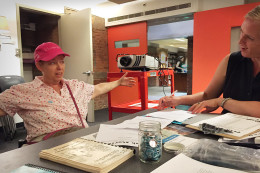 We’ve been really busy soliciting recipes and stories for the Fish Stories Community Cookbook. In the past few weeks we’ve held workshops or shown up to talk with people at the Hamilton-Madison House Senior Center, the fishing clinic at the Lower East Side Ecology Center, the P.S. 184 Shuang Wen School Summer Carnival Fundraiser, the after school program 2 Bridges Kids! at Two Bridges Neighborhood Council, the Loisaida Festival, Family Day at the Vladeck Houses, Weinberg Center for Balanced Living at the Manny Cantor Center, a performance at Pier 42 by Arm of the Sea Theater and, most recently, held a seafood recipe exchange at the Mulberry Street Branch of the New York Public Library.
We’ve been really busy soliciting recipes and stories for the Fish Stories Community Cookbook. In the past few weeks we’ve held workshops or shown up to talk with people at the Hamilton-Madison House Senior Center, the fishing clinic at the Lower East Side Ecology Center, the P.S. 184 Shuang Wen School Summer Carnival Fundraiser, the after school program 2 Bridges Kids! at Two Bridges Neighborhood Council, the Loisaida Festival, Family Day at the Vladeck Houses, Weinberg Center for Balanced Living at the Manny Cantor Center, a performance at Pier 42 by Arm of the Sea Theater and, most recently, held a seafood recipe exchange at the Mulberry Street Branch of the New York Public Library.
Wow, we’ve met a lot of great people and received many great recipes. Talking to people one on one is much more effective than directing people to the forms on our website for soliciting recipes, as you might imagine. At yesterday’s recipe exchange Judy Hiller-Schwartz gave me recipes for Gravlox with Mustard Dill Sauce, Gifilte Fish and ‘Jewish Style’ Halibut “Creole.” She also told me about her trials and tribulations starting up a business making knishs. A favorite place of hers to buy fish in the Lower East Side is Rainbow Fish in Essex Market and she suggested talking to Ira.
A very special thanks to Sherri Machlin, the librarian who helped to organize, promote and champion the event. She has a book of her own – American Food by the Decades.

